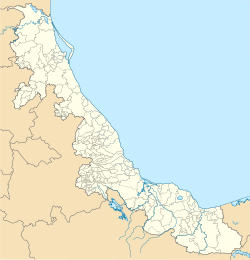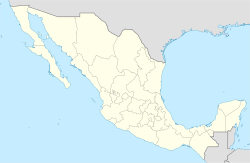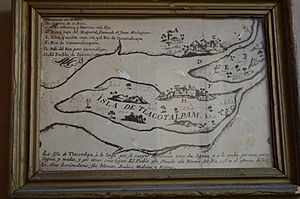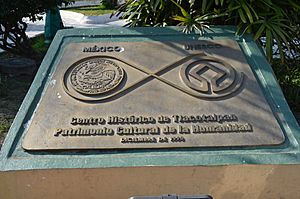Tlacotalpan facts for kids
Quick facts for kids
Tlacotalpan
|
|
|---|---|
|
Town
|
|
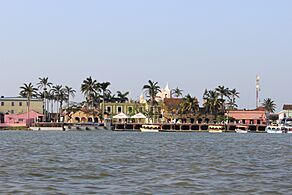
Tlacotalpan seen from the Papaloapan river
|
|
| Country | |
| State | Veracruz |
| Town status | 1847 |
| City status | 9 May 1865 |
| Elevation | 10 m (30 ft) |
| Population
(2010)
|
|
| • Total | 8,853 |
| Time zone | UTC-6 (Central (US Central)) |
| Website | Municipio de Tlacotalpan |
| UNESCO World Heritage Site | |
| Official name | Historic Monuments Zone of Tlacotalpan |
| Criteria | Cultural: ii, iv |
| Inscription | 1998 (22nd Session) |
| Area | 75 ha |
| Buffer zone | 320 ha |
Tlacotalpan is a charming city in the Mexican state of Veracruz. It was named a World Heritage Site by UNESCO in 1998. This means it's a very special place that the world wants to protect. It's famous for its beautiful buildings and how the city is laid out, which dates back to the time when Spain ruled Mexico.
The town started in 1550 on what used to be an island in the Papaloapan River. For a long time, it was a super important port. It was one of the few river ports in all of Latin America! But when railroads were built, Tlacotalpan's importance slowly faded. In recent years, people have worked hard to save the city's unique Spanish and Caribbean style. Now, its main ways to make money are fishing and tourism. Many visitors come for the big yearly festival honoring Our Lady of Candlemas.
Contents
Exploring Tlacotalpan
Tlacotalpan is often called the "pearl of the Papaloapan." It's unique because it's a river port, not right on the ocean. It's a World Heritage Site because of its special design, old buildings, history, and traditions.
City Layout and Architecture
The city's design and buildings are from the 1600s. Most of the town still looks like it did back then. It's laid out like a checkerboard with 153 blocks. The city is split into two parts: a "Spanish" section and a smaller "native" section. A public area with shops and government buildings separates them.
The Spanish part has wide streets that run next to the Papaloapan River. Narrow lanes connect these streets. You'll find parks and public spaces with old trees here. One famous spot is Parque Hidalgo, known for its musicians. Another is Plazuela de Doña Maria, where workshops make furniture and musical instruments.
The houses are usually one or two stories tall. They have cool inner courtyards, like homes in Spain. They also have Caribbean-style arches, red-tile roofs, and colorful fronts. Some of these houses are from the 1700s! Many homes still have their original inside design and old furniture.
The Riverfront and Main Square
Even though it's not as busy as it once was, Tlacotalpan is still a river port. It mainly serves fishing boats. There's a long cement dock and a boardwalk along the river. Many restaurants line the boardwalk.
A little back from the river is the main square, called Plaza Zaragoza. It has white marble and lots of palm trees. In the middle, there's a beautiful kiosk from the 1800s.
Important Churches
The main church in the plaza is the Sanctuary of Our Lady of Candlemas. It was built in the late 1700s. It holds a special image of the Virgin Mary that sailors brought to the town long ago. The city's biggest yearly celebration fills this church with candles and flowers.
Another church in the plaza is the San Cristóbal Parish, built in 1849. It has a classic style with some old Moorish touches. Its tower has a clock said to be from England, over 200 years old! Inside, there's a beautiful wooden altar and a special altar for Jesus.
But the oldest church still standing is the San Miguelito Church. It was built in 1785.
Other Key Buildings
The municipal palace is also in Plaza Zaragoza. It was built in 1849. Inside, you can see paintings by Salvador Ferrando. It also has old documents from the time of Spanish rule.
Just east of the Sanctuary is a small plaza named Plazuela Agustín Lara. It has a statue of the famous songwriter Agustín Lara. The Casa Artesanal Rafaela Murillo de Barbero is here. It used to be the town jail! Now, it sells beautiful embroidered clothes and wooden crafts.
The Salvador Ferrando Museum is also nearby. It's in the house where the painter Salvador Ferrando used to live. He was important for saving Veracruz's culture. The museum has his art and old items from his time.
Cultural Spots
The Agustín Lara House Museum is a very active cultural spot. It's dedicated to the songwriter and poet who lived much of his life here. It shows photos and items from Lara's life. You can also see works by other local artists.
Another place linked to Lara is the Blanca Nieves Cantina. It was his favorite hangout! He would drink local drinks called "toritos" with friends. It's been open for over sixty years. Its name, "Snow White" in Spanish, was given by Lara himself. It honored the owner, Tobías Carbajal, and his seven children. The bar also has a museum part with a unique statue of Lara.
The town's cultural center is also named after Lara (Casa de Cultura Agustín Lara). It's a place where artists, musicians, and dancers meet. They offer classes in traditional Veracruz dance and music. It also has a permanent display about Lara and paintings by local artists.
The Nezahuacoyotl Theater was built in 1891. It has a French style.
There's also a "mini zoo" in a converted house. It belonged to Pío Barrán. It has a collection of items and animals, especially from movies Barrán collected. It even has things related to Agustín Lara. The most unusual part is the exotic animals, like crocodiles, turtles, and pelicans, some of which roam freely!
The Jardín del Arte Tlacotalpeño (Tlacotalpan Art Garden) shows and sells art by local artists. It's just south of the main square.
Music and Festivals
One of Mexico's most exciting festivals is the celebration of the Virgen de la Candelaria in Tlacotalpan. From January 31 to February 2, thousands of people fill the streets. Many local families open their homes to visitors.
During this festival, there's a big meeting of "Jaraneros" and "Versadores." These are musicians and poets who perform traditional music. Many groups play for hours. After these performances, a "fandango" begins. This is a lively party with music and dancing. Fandangos also happen in front of the San Miguelito church.
Geography and Environment
Tlacotalpan is in the middle of Veracruz state in eastern Mexico. It's about 90 kilometers from the port of Veracruz. It's part of the Sotavento Region.
The land around Tlacotalpan is mostly flat, with some small hills to the west. A lot of the land is used for raising animals. Some is used for farming, and a good part is covered by water.
The Papaloapan River is very important here. The San Juan and Tuxpan Rivers flow into it. The Papaloapan can be used by boats.
Climate and Nature
The area has a semi-tropical climate. The average temperature is about 25.1 degrees Celsius. There are two main seasons. From October to April, cold winds from the north, called "nortes," bring strong winds. The rest of the year, warm, humid winds from the Atlantic bring most of the rain. September is the stormiest month. The area also gets hurricanes often, which can cause big floods.
The plants here lose their leaves in certain seasons. Common trees include holm oak, ash, willow, and poplar. There are also areas with mangroves.
History of Tlacotalpan
The name "Tlacotalpan" comes from an old language called Nahuatl. It means "land between the waters." This refers to how the first settlement was on an island in the Papaloapan River. Later, the river bank was changed, and the island became part of the mainland.
Not much is known about the very early history of the area. The Totonacs lived here first. Then, the Toltecs came in the 1100s. Later, the Aztecs took control in the 1400s.
Spanish Arrival and Growth
In 1518, Pedro de Alvarado explored the Papaloapan area. After the Spanish conquered Mexico in 1521, a Spanish leader named Alfonso Romero received the area. In 1532, the first sugar cane mill in Mexico was set up here. In 1550, the Spanish king gave the land to Gaspar Rivakeneyra. He couldn't stop fishermen from building a town, but he made them build a chapel for Our Lady of Candlemas.
The area grew slowly. By 1777, there were only 320 Spanish people. In 1808, there were over 1,100 native people and over 1,600 people of mixed native and African heritage.
In the 1600s, Tlacotalpan became a trading center for nearby farms. This made its Spanish population grow. Its wealth and port status attracted English pirates in the 1600s and 1700s. The city was even burned down by pirates in 1667.
In 1714, the Papaloapan River flooded. This forced the city to move to its current spot. The town also had three other big fires in 1698, 1788, and 1790. After the last two fires, leaders made people rebuild with stone walls, tile roofs, and open spaces with trees. This is why many of the oldest buildings look the way they do today.
A Busy Port City
Tlacotalpan was most important as a port city in the 1800s. People from France, Germany, and Italy came to grow cotton. From 1821, Tlacotalpan grew as a port. It shipped goods from other Mexican states to the city of Veracruz and even to places like New Orleans and Havana. By 1855, it had many steamships and sailing ships. They carried wood, tobacco, sugar, leather, and more.
In 1825, one of Mexico's first sailing schools opened here. In 1847, Tlacotalpan was officially called a town. This was because it helped defend against U.S. forces during the Mexican–American War. In 1865, it was declared a city. This was because it bravely resisted French forces.
Later, the railroad was built. This made Tlacotalpan less important as a port. Its population has stayed about the same since the 1980s.
Protecting Tlacotalpan's Heritage
In 1968, people started working to save Tlacotalpan. The state of Veracruz called it a "typical city" of Mexico. In 1986, the Mexican government declared it a Historic Monuments Zone. This meant special groups would protect it.
In 1998, UNESCO named it a World Heritage Site. This was because of its history as a river port, its unique buildings, and its traditions in poetry, music, and dance. Since then, groups have worked to make the city better and help its economy, especially through tourism.
Images for kids
See also
 In Spanish: Tlacotalpan para niños
In Spanish: Tlacotalpan para niños


